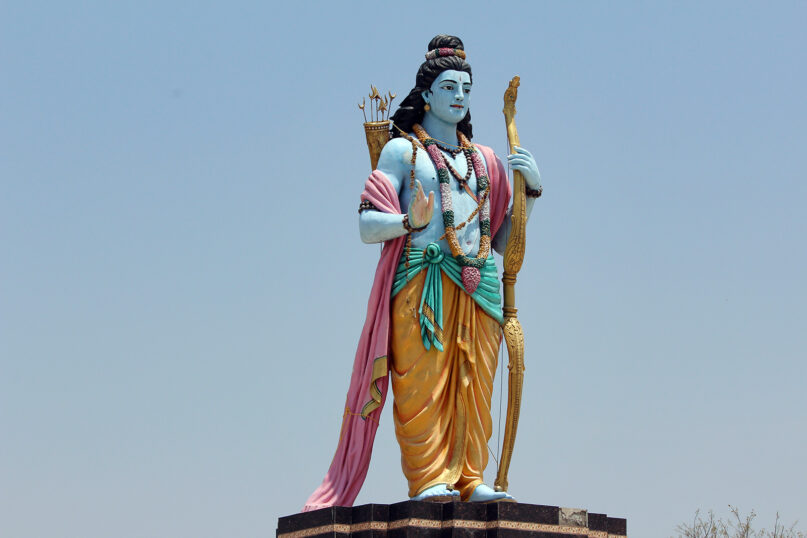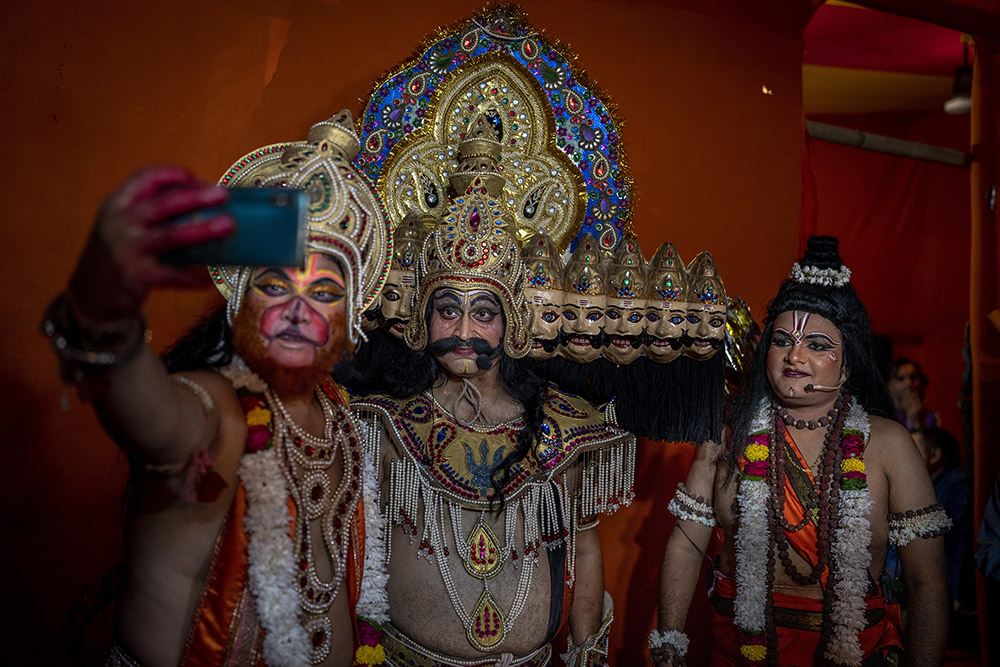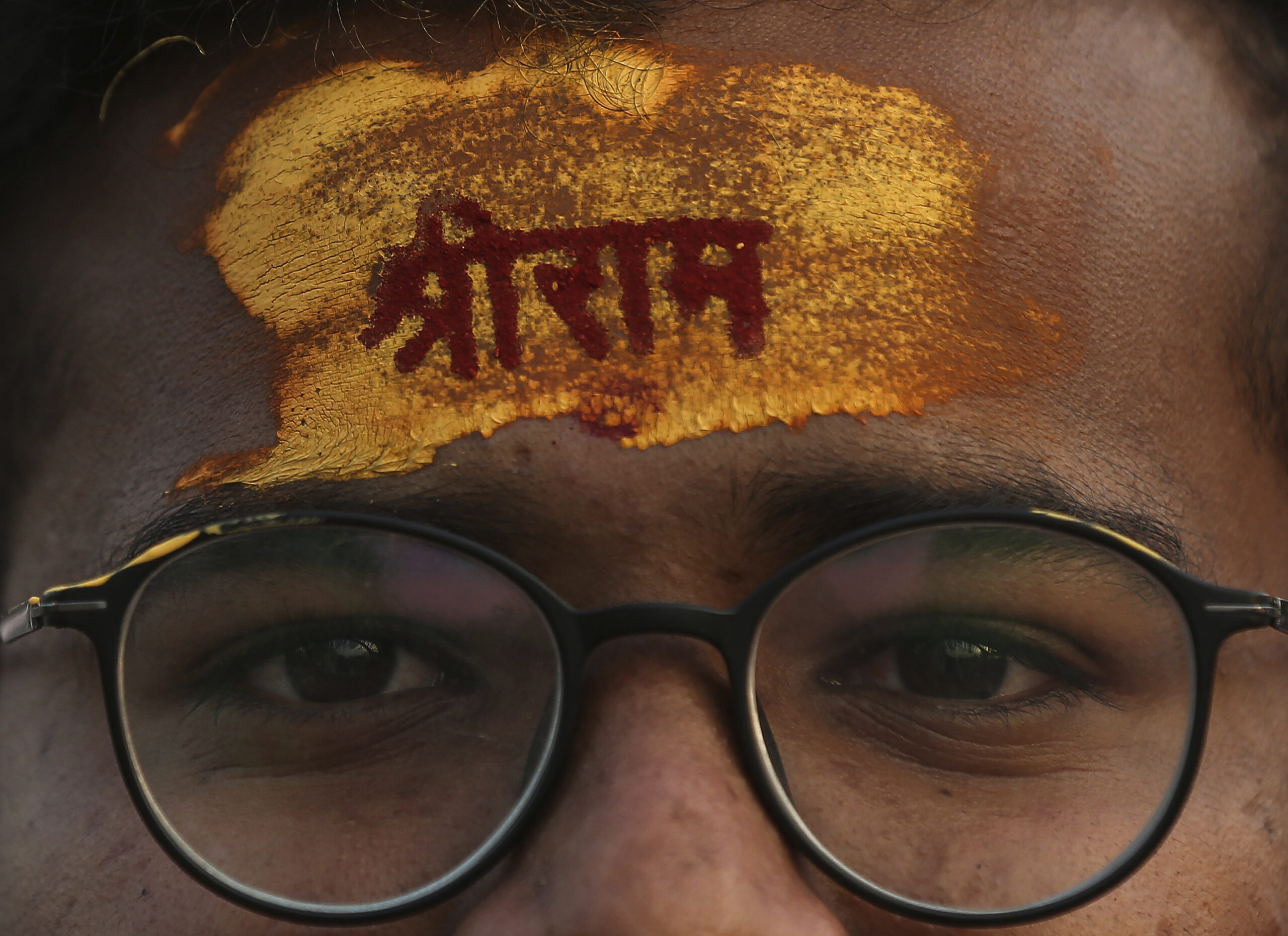It’s Lord Ram’s birthday this week. Here’s why he’ll be remembered in six faiths.
This week, millions will mark the birth of one of the most iconic figures in global lore.

(RNS) — In a climactic scene of “RRR,” the Telugu-language blockbuster, one of the protagonists, an Indian freedom fighter named Ram, transforms into an icon of Lord Ram, an incarnation of the god Vishnu and one of the most important deities in Hinduism. With Ram’s bow and arrow, the mortal Ram defeats the British colonizers.
The scene, and the success of “RRR,” is an example of how Ram has grown in the Western imagination in the past three decades or so, beginning with his depiction in the popular 1995 screen version of Frances Hodgson Burnett’s classic children’s tale, “The Little Princess.”
But Ram, also called Rama, has for centuries been influential wherever Hinduism spread around the globe, even among believers in Islam, Christianity and Sikhism. This week, his birthday will be celebrated by millions of Hindus and members of other faiths on Ram Navami, the last day of the nine-day Chaitra Navratri festival.
While some scholars have recently begun to suggest that Ram was likely an actual ruler in ancient India (or a composite of several), the scriptural version of Ram has had an outsized impact on Hindus and followers of Buddhism, Jainism, Sikhism, Islam and Christianity.
The Ramayana, the Sanskrit epic attributed to Sage Valmiki, a former bandit turned Hindu rishi, tells the life of Ram, a human prince and fierce warrior who marries the princess Sita. Ram is about to inherit his father’s throne when his stepmother, in a succession struggle, schemes to send Ram into exile. While Ram and Sita are abroad, Sita is kidnapped by the demon king Ravana and Ram must rescue her with the help of the monkey god Hanuman.
The sacred text, which highlights the importance of virtue and the victory of light over darkness, is one of the bases of the Hindu festival of Diwali, which marks Ram’s return from exile.

An artist dressed as Hindu monkey god Hanuman, left, takes a selfie with artists dressed as demon king Ravana, center, and Hindu god Ram, right, before a final Ramleela performance as part of Dussehra festival celebrations in New Delhi, India, Oct. 5, 2022. (AP Photo/Altaf Qadri)
The Ramayana also idealizes dharma, the central tenet of Hinduism, Buddhism, Jainism and Sikhism. Ram always puts duty and righteousness above all else, qualities that have helped his legend survive even in societies where Hinduism is no longer practiced as widely, if at all. Most importantly, it teaches that no one is completely good or completely evil, an idea underscored by its villain, Ravana, a staunch devotee of Lord Shiva who became blinded by power.
Over time, both Jainism and Buddhism adopted versions of the Ramayana as part of their religious lore. In Cambodia, Malaysia, Vietnam, Thailand, Sri Lanka and Indonesia, once Hindu strongholds, the Scripture’s importance as a guide to virtue remained even as their populations were converted to other faiths. In mostly Buddhist Cambodia, the Ramayana is known as the Reamker, or the Glory of Rama, while in Muslim-majority Indonesia, it is a national symbol and intricately woven into the country’s social fabric.
But even though it spawned many local versions, Valmiki’s epic was inaccessible to millions of Hindus, who did not read or write Sanskrit until the 1600s, when St. Tulsidas, one of the greatest figures of the Hindu bhakti movement, penned the Ramcharitmanas, a poem that extols the accomplishments of Ram, in Awadhi, a language linked to Ayodhya, Ram’s birthplace. Tulsidas, who had been imprisoned by the Mughal emperor Akbar, is widely believed to have composed the poem on Ram’s birthday.
As millions of impoverished Hindus left India in the 19th century as indentured servants and scattered across the British Empire, the Ramcharitmanas became a unifying source of comfort.
Because of the syncretic connections between Sikhism and Punjabi Hinduism, many Sikhs came to view Ram as king of Ayodhya, though there are some disagreements about whether Sikh gurus also considered him a divine being. Still, Ram is mentioned in both the Guru Granth Sahib and the Dasam Granth, a text long considered to be one of the works of Guru Gobind Singh, the 10th in Sikhism’s lineage of founding teachers. In recent years, some Sikh groups, particularly in the diaspora, have pushed back on that idea.

A devotee has the name of Hindu god Rama written on his forehead during a religious procession to celebrate Ram Navami, a Hindu festival marking the birth anniversary of Lord Ram, in Hyderabad, India, April 10, 2022. (AP Photo/Mahesh Kumar A., File)
The Meo Muslims of northern India have long revered Ram and trace their roots to him, and many men in the community still take names with roots in the Ramayana. However, in recent years, some Meos have abandoned Ram and other Hindu traditions due to a rise in both right-wing Hindu sentiment and Islamic puritanism fueled by money from Arab states.
But Muslims in other parts of the world still hold the Ramayana in deep reverence. Its story was long retold in popular Balinese and Javanese shadow puppetry known as Wayang golek until Muslim rulers disapproved. Refashioned into the more palatable Wayang kulit, it maintains the same references to Ram. Many Indonesian Muslims continue to draw their names from the Ramayana and the country’s national airline is called Garuda, the mythological bird that makes appearances in numerous Hindu stories.
Far from India, in the Caribbean countries of Guyana, Jamaica and Trinidad and Tobago, names like Ramsingh, Rampersuad, Ramkissoon, Ramnarine and Sitaram continue to be common, even among West Indians whose families have long since become Christian. In at least some of these converted communities, celebrating Diwali, specifically Ram’s return, continues, though a rise in evangelical Christian activity in recent years has lessened those observances.
Still, Ram Navami marks the birth of a figure whose life and lionization continue to play a major role in the lives of hundreds of millions across the world. On Thursday (March 30), millions of homes around the world will mark the occasion with readings of the Ramayana or Ramcharitmanas, fasting and musical odes to the greatness of one of the most iconic figures in global lore.
(Murali Balaji is a journalist and a lecturer at the Annenberg School for Communication at the University of Pennsylvania. His books include “Digital Hinduism” and “The Professor and the Pupil,” a political biography of W.E.B. Du Bois and Paul Robeson. The views expressed in this commentary do not necessarily reflect those of Religion News Service.)
No comments:
Post a Comment